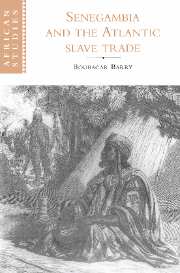Book contents
- Frontmatter
- Contents
- Preface
- Map
- I Senegambia from the fifteenth to the seventeenth century: a haven for incoming populations, a station for migrants on the move
- 1 Senegambia in the fifteenth and sixteenth centuries: dependence on the Sudan and the Sahara
- 2 Social dynamics in Senegambia
- 3 The Atlantic trading system and the reformation of Senegambian states from the fifteenth to the seventeenth century
- 4 The partition of the Senegambian coast in the seventeenth century
- II Senegambia in the eighteenth century: the slave trade, ceddo regimes and Muslim revolutions
- III Senegambia in the first half of the nineteenth century: legitimate trade and sovereignty disputes
- IV Senegambia in the second half of the nineteenth century: colonial conquest and resistance movements
- Conclusion
- Notes
- Bibliography
- Index
- Other books in the series
3 - The Atlantic trading system and the reformation of Senegambian states from the fifteenth to the seventeenth century
Published online by Cambridge University Press: 31 October 2009
- Frontmatter
- Contents
- Preface
- Map
- I Senegambia from the fifteenth to the seventeenth century: a haven for incoming populations, a station for migrants on the move
- 1 Senegambia in the fifteenth and sixteenth centuries: dependence on the Sudan and the Sahara
- 2 Social dynamics in Senegambia
- 3 The Atlantic trading system and the reformation of Senegambian states from the fifteenth to the seventeenth century
- 4 The partition of the Senegambian coast in the seventeenth century
- II Senegambia in the eighteenth century: the slave trade, ceddo regimes and Muslim revolutions
- III Senegambia in the first half of the nineteenth century: legitimate trade and sovereignty disputes
- IV Senegambia in the second half of the nineteenth century: colonial conquest and resistance movements
- Conclusion
- Notes
- Bibliography
- Index
- Other books in the series
Summary
The course of Senegambian history was radically changed with the arrival of Europeans on the coast. The Portuguese impact was the most spectacular. The seacoast became, from then on, the leading front for acculturation. The settlement of the Portuguese at Arguin around 1445 was the first victory of the caravel over the caravan. Its consequence was the rerouting of trade circuits toward the Atlantic.
Portuguese seeking gold attempted to penetrate into the Sudan along the Senegal River and, more energetically, along the Gambia. But the Felu Falls made navigation up the Senegal River difficult. Along the Gambia, too, the Portuguese faced problems from the dominant Manding. When, in 1488, their attempts to build a fort on the banks of the Senegal River failed, the Portuguese resorted to trading along the coast and up the estuaries of the Senegal and the Gambia, using boats shuttling in from the Cape Verde islands. They established a solid foothold in the Southern Rivers region and in the Gambia because the region was important in the inter-regional trade of Senegambia.
Portuguese traders, dealing in gold, ivory, hides, spices, and – right from the start – slaves, used the old inter-regional trade circuit for cola, salt, cotton cloth, and iron. Under the Portuguese monopoly, this trade produced profound changes as early as the mid-sixteenth century. In particular, it reshaped the political map of Senegambia.
- Type
- Chapter
- Information
- Senegambia and the Atlantic Slave Trade , pp. 36 - 45Publisher: Cambridge University PressPrint publication year: 1997



